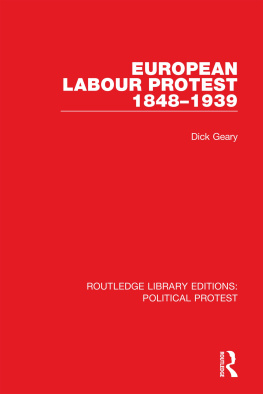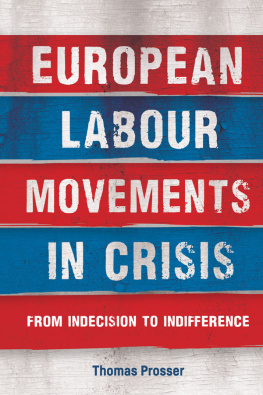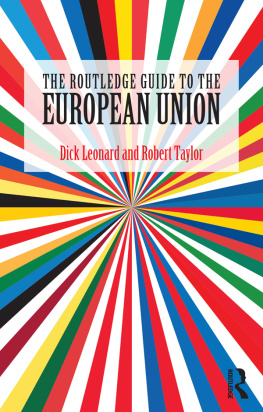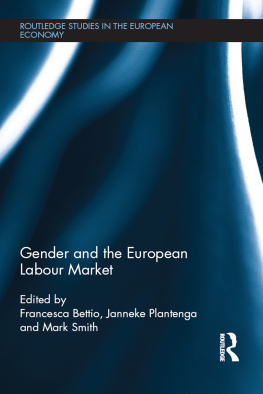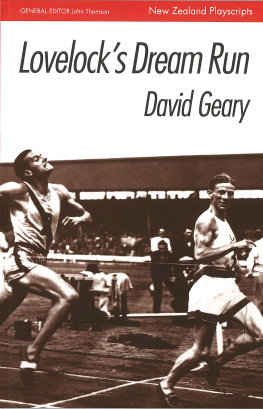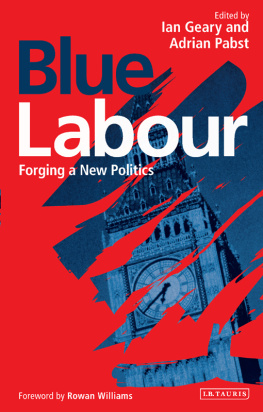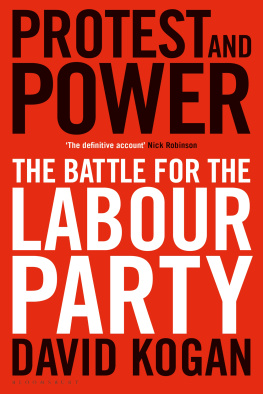ROUTLEDGE LIBRARY EDITIONS: POLITICAL PROTEST
Volume 7
EUROPEAN LABOUR PROTEST 18481939
EUROPEAN LABOUR PROTEST 18481939
DICK GEARY
First published in 1981 by Croom Helm Ltd
First published as a University Paperback in 1984 by Methuen & Co. Ltd
This edition first published in 2022
by Routledge
2 Park Square, Milton Park, Abingdon, Oxon OX14 4RN
and by Routledge
605 Third Avenue, New York, NY 10158
Routledge is an imprint of the Taylor & Francis Group, an informa business
1981 Dick Geary
All rights reserved. No part of this book may be reprinted or reproduced or utilised in any form or by any electronic, mechanical, or other means, now known or hereafter invented, including photocopying and recording, or in any information storage or retrieval system, without permission in writing from the publishers.
Trademark notice: Product or corporate names may be trademarks or registered trademarks, and are used only for identification and explanation without intent to infringe.
British Library Cataloguing in Publication Data
A catalogue record for this book is available from the British Library
ISBN: 978-1-03-203038-8 (Set)
ISBN: 978-1-00-319086-8 (Set) (ebk)
ISBN: 978-1-03-203678-6 (Volume 7) (hbk)
ISBN: 978-1-03-203680-9 (Volume 7) (pbk)
ISBN: 978-1-00-318846-9 (Volume 7) (ebk)
DOI: 10.4324/9781003188469
Publishers Note
The publisher has gone to great lengths to ensure the quality of this reprint but points out that some imperfections in the original copies may be apparent.
Disclaimer
The publisher has made every effort to trace copyright holders and would welcome correspondence from those they have been unable to trace.
European Labour Protest 1848-1939
DICK GEARY
First published in 1981 by Croom Helm Ltd
First published as a University Paperback in 1984 by
Methuen & Co. Ltd
11 New Fetter Lane, London EC4P 4EE
1981 Dick Geary
Printed in Great Britain by
J. W. Arrowsmith Ltd, Bristol
All rights reserved. No part of this book may be reprinted or reproduced or utilized in any form or by any electronic, mechanical or other means, now known or hereafter invented, including photocopying and recording, or in any information storage or retrieval system, without permission in writing from the publishers.
British Library Cataloguing in Publication Data
Geary, Dick
European labour protest 1848-1939.
(University paperback 850).
1. Labour and labouring classesEuropeHistory
2. Labour and labouring classesEurope
Political activityHistory
I. Title
335.0094 HD8376
ISBN 0-416-33840-2
In nineteenth- and early-twentieth-century Europe government authorities and the traditional ruling strata viewed various forms of lower-class protest almost always as the work of agitators, conspirators or preferably outsiders. Thus the British government of 1842 attempted to portray the confused strikes and riots of that bitter year as a coherent and concerted conspiracy, the so-called Plug Plot. Thus King Frederick William IV of Prussia chose to believe that the revolution of 1848 had been systematically prepared by unsavoury characters dwelling in foreign parts; and thus many European governments mistook the insurrection of the Paris Commune in 1871 for the work of an international organisation of conspirators, Karl Marxs International Working Mens Association (the First International). As late as 1918 many German aristocrats, and not only they, could believe quite firmly that the November Revolution of that year was brought about by the machinations of Slavs and Jews.
That the upper crust should see the mechanics of protest in such a blinkered fashion is hardly surprising. To lay the blame for disruption on a small minority of ungrateful misfits, alien scum or even politically motivated trade union leaders was and in some quarters still is good propaganda. The limited horizons of an entrenched but fearful elite are further and easily explained in terms of the isolation or limited social intercourse of such a group. What is more difficult to explain and certainly less excusable is that historians of the socialist and labour movements have themselves so often resorted to a modified version of the conspiracy theory. In this context British labour historiography is the exception rather than the rule. The relative absence and insignificance of inspiring ideological controversy or institutional socialism in Britain before the turn of the century in a sense obliged historians to turn their attention to the grass-roots activity of ordinary working men (and more rarely women) in the absence of anything more exciting. On the Continent, however, things were different. The early appearance of revolutionary socialism in France and Much of what follows will provide further evidence of ideological ignorance or confusion on the part of the membership of various socialist parties and radical groups.
Obviously there have been innumerable studies of the non-ideological history of European labour; but most of these have been institutional histories of political parties and trade unions. Such work needs to be done; but most of it has been written from the top downwards: divisions within the labour movement have been seen through the eyes of union and party leaders rather than through the ordinary experience of the working-class rank and file. Most arguments to the effect that the German labour movement became less radical in the period before the First World War, for example, are based on an analysis of the behaviour and attitudes of the party leadership of the
There are several reasons why the institutional and leadership approach fails to do justice to the history of the European socialist movement. In the first place, most of the socialist parties which came into existence in the nineteenth century and some of their Communist successors were mass political movements, involving thousands, even hundreds of thousands, of members: on the eve of the First World War the SPD had a membership of over a million, for example. In addition these organisations, at least in their early days, were democratic and their rank and file had some, albeit a declining, influence on the decisionmaking process. There were also occasions on which rank and file opposition to official leadership became manifest, as we shall see. Hence any adequate attempt to grapple with the history of the SPD, of the French Socialist Party, the SFIO (Section Franaise de lInternationale Ouvrire), or of the Italian Socialist Party (PSI), will have to take into account the attitudes and activities of the working-class rank and file.
At this point, however, further difficulties arise. Even if we were able to construct an adequate history of the organised socialist movement, vast areas of labour protest would remain unexplored. Many workers joined trade unions and the ranks of industrial protest -strikes, for example - and yet refused or did not consider extending their support to organised socialism, most obviously in Britain. Perhaps even more significantly, most workers belonged to no organisation at all before 1914, even in the advanced industrial nations of Europe: on the eve of the First World War no more than 9 per cent of the French, 25 per cent of the German and slightly more of the British labour force had been recruited into economic or political organisations. Not only that, but many workers who had never been organised previously often participated in strikes and even more radical forms of activity. The unorganised, for example, played a major role in the strike waves of 1905 in Germany and Russia, in the revolutionary events in the latter country in 1917 and in the former in 1918, as they also did in the French upheavals of 1936. Any study of labour protest, therefore, cannot restrict its concerns solely to ideologies, institutions or leaders.



